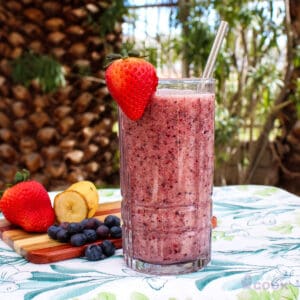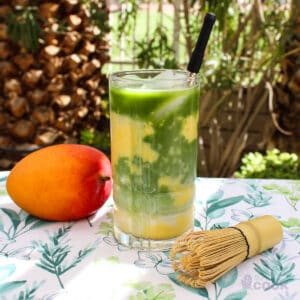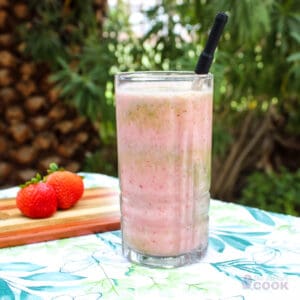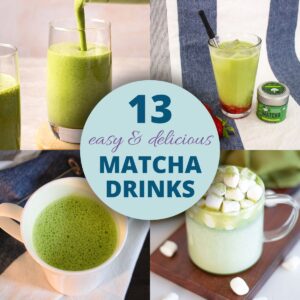Both culinary and ceremonial matcha grades can be delicious, when used in the ways that are suitable to each tea type.
There are several major differences between ceremonial matcha and culinary matcha. Here, we’ll review what those are and what’s actually important when choosing a matcha powder.
No time to read now? Pin it for later!

This post contains affiliate links, which means I receive a small commission, at no additional cost to you, if you make a purchase using this link.
First, what IS matcha?
Matcha is a green tea powder made from young tea leaves that are ground up into a fine powder. The matcha is then used in a variety of ways, from traditional japanese tea ceremonies where it is combined with hot water with a bamboo whisk, to matcha lattes in coffee shops, or even put in ice cream or other desserts.
Why is it so popular now?
Matcha has a number of health benefits, as well as practical perks. Unlike regular tea bags, you consume the entire leaf when you drink matcha. The tea is also shade-grown which boosts nutrient production. Like regular green tea, matcha has great antioxidants.
Practically, the L-theanine amino acids in matcha work with caffeine to improve focus as well as energy. I personally find that a matcha beverage avoids the jitters of other caffeine sources, and lasts longer.
When you first discover matcha, the most obvious difference is in price
Culinary matcha is generally much more economical, and ceremonial pricing ranges widely.
Of course, what each company designates as ceremonial is based on their own standards, so what one company might call culinary another might label as ceremonial, which makes it all the more confusing. Additionally, some brands don't label their grade. One of the four matchas here- the Republic of Tea- pictured only says culinary on the barcode sticker description rather than the product itself, so it wasn't obvious to me when I ordered it which it was.
When the tea is harvested impacts taste
From a tea growers perspective, the main difference is when they are harvested. Meanwhile from a consumers perspective, the main difference is color and taste.
Ceremonial matcha is often called first harvest, or first tea. These younger green tea leaves have a more delicate taste, more natural sweetness, and are lighter in color with a vibrant green hue. These attributes are why first harvest is considered the highest quality matcha.
Later harvests have been exposed to more sunlight so have more chloraphyll, as well as a deeper, earthier flavor that is a more bitter taste when compared with ceremonial grade tea. The older tea leaves have less caffeine and L-theanine, but more catechins (antioxidants).
In the image below, you can see ceremonial teas on the left, easily identified by their vibrant green color. Both culinary japanese green teas on the right are a much more muted shade of green.

Top left is Jade Leaf, top right is Pure Leaf, bottom left is Kyoto Dew, and bottom right is Republic of Tea.
How should the different grades of matcha be used?
Ceremonial grade matcha powder is often marketed as premium matcha and considered higher quality, and is suitable for any matcha drink.
Culinary grade matcha powder is used for cooking and baking, and can often be found in lattes- and many culinary matcha powders will list this as a way to use them on the packaging. This is because while it doesn't have the more delicate and naturally sweet taste of very high quality matcha, latte beverages are usually sweetened with sugar or syrup. Similarly, baked goods also usually have a fair amount of sugar, so using older tea plants doesn't impact the taste as much.
What other factors are important?
Matcha leaves are generally stone-ground to form a very fine texture. A common misconception is that ceremonial grade is a more fine powder, but as we've discussed it really comes down to when they're harvested, as the youngest tea leaves are what are truly ceremonial and used in traditional tea ceremonies.
That said, how fine a powder is can impact how readily it mixes with water. While a coarser powder may not actually be lower quality, if your matcha powder clumps in your beverage you might not enjoy the little bits of powder from either a taste or texture perspective.
In the image above you can see I smudged all four matchas with my finger on the paper, which is sometimes done when testing smoothness. All spread reasonably well, but the top row was definitely a finer powder. However they all left reasonably clean lines, and with my electric whisk all four blend just fine.
Speaking of whisking the matchas, a high-quality matcha will form a creamy froth layer with small air bubbles. A lower grade of matcha will tend to form a thin layer with large air bubbles. Again, when baking that's no big deal, and if pouring into a latte is a matter of taste, but if combined with just water that creamy mouth feel makes a difference.
So what is the best matcha?
The beautiful thing about matcha, like many foods, is it really comes down to your personal preference. I enjoy using ceremonial or first harvest leaves for all of my beverages, but I also don't tend to heavily sweeten my usual latte so the teas natural flavor shines through, and if I'm making a sweeter strawberry latte I still prefer the extra caffeine in ceremonial.
Different tea brands are also grown in various regions, and based on the soil and exact harvest season will have different flavor profiles.
If you're just getting started with matcha and have a Trader Joe's near you, they offer single serve packets in a set of 7 that are a great introduction to see how you like it. Jade Leaf and Kyoto Dew are my favorites, and have light, delicate flavors. Not pictured is Akira which is a close third, though a little earthier of a flavor it's still a beautiful bright green color.
For baking I prefer the Pure Leaf because it does mix so well with flour. The Republic of Tea I'm not likely to repurchase, mostly because for a culinary grade it's on the higher end of pricing. However, I've used it in my strawberry matcha latte and I will certainly use it up!
How about you?





Leave a Reply